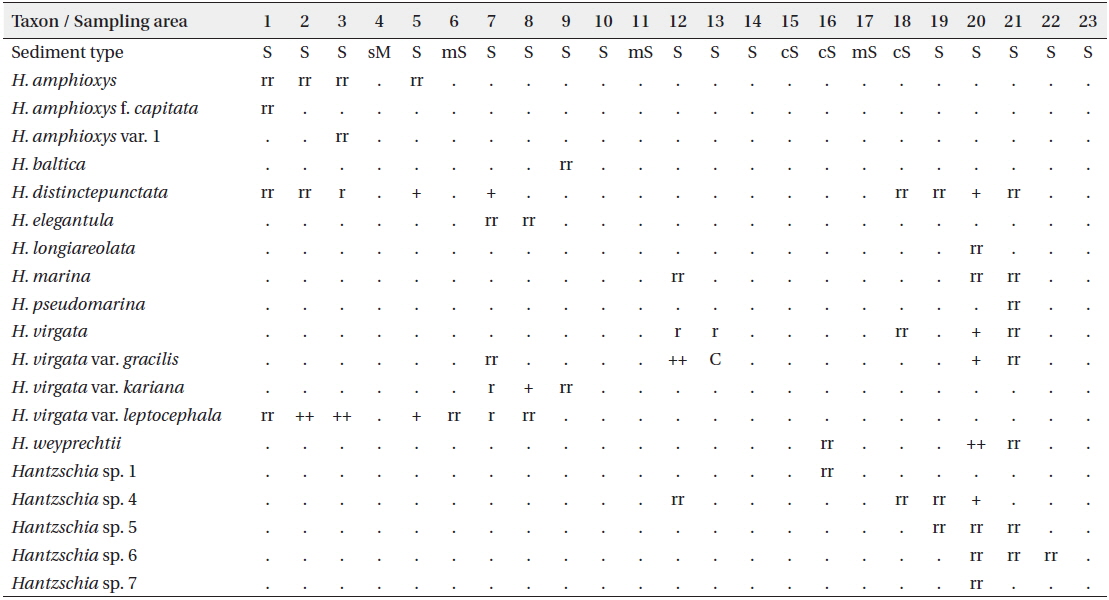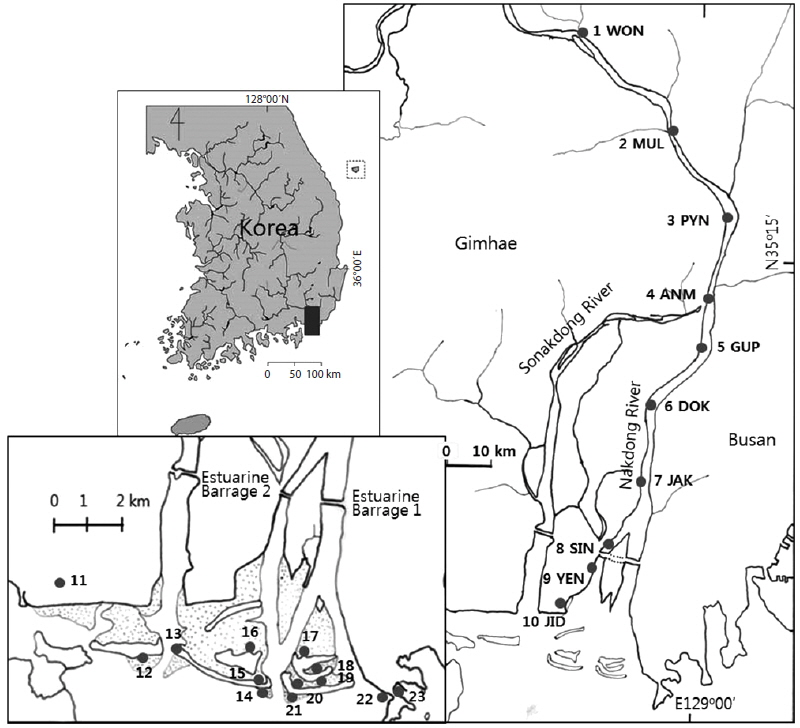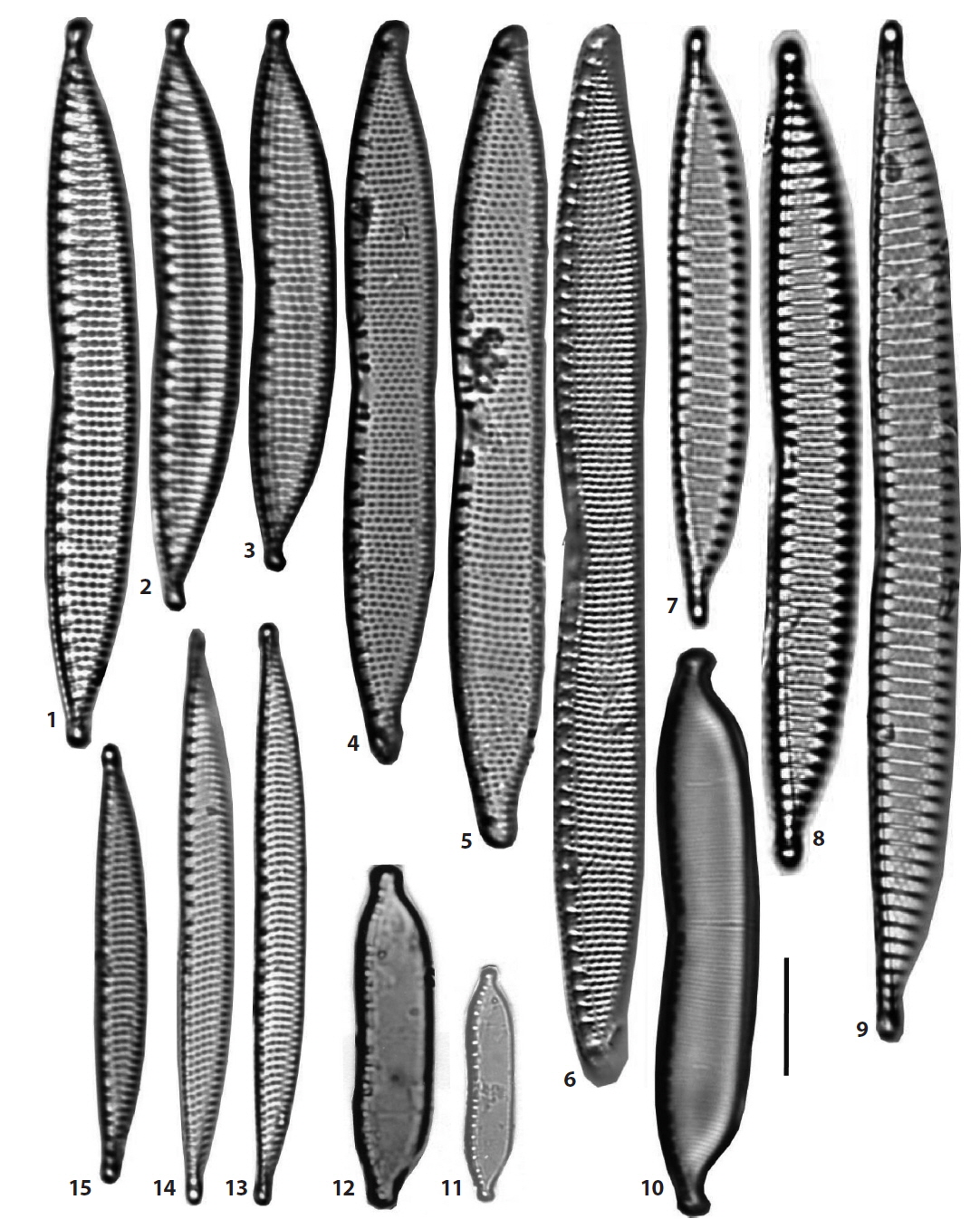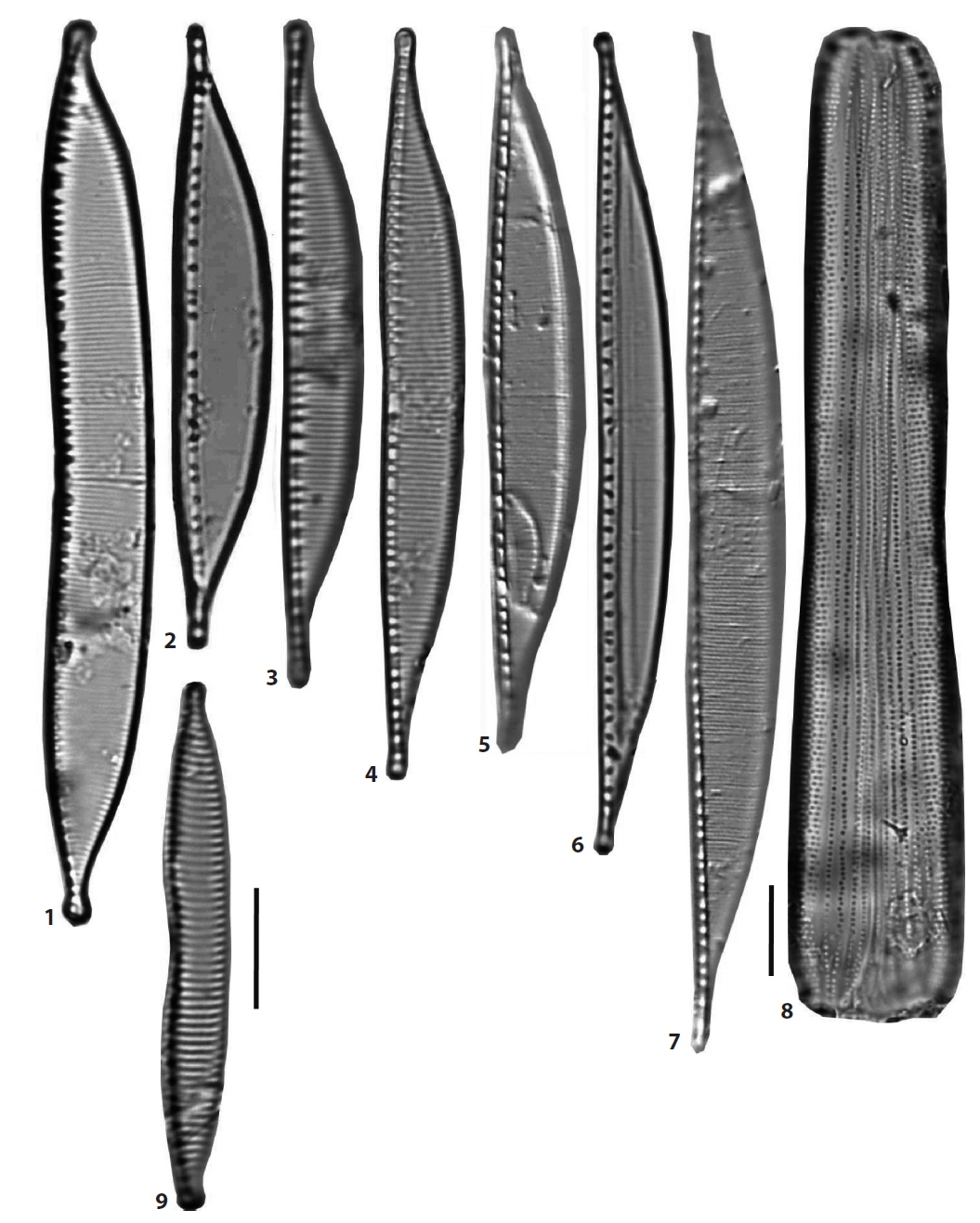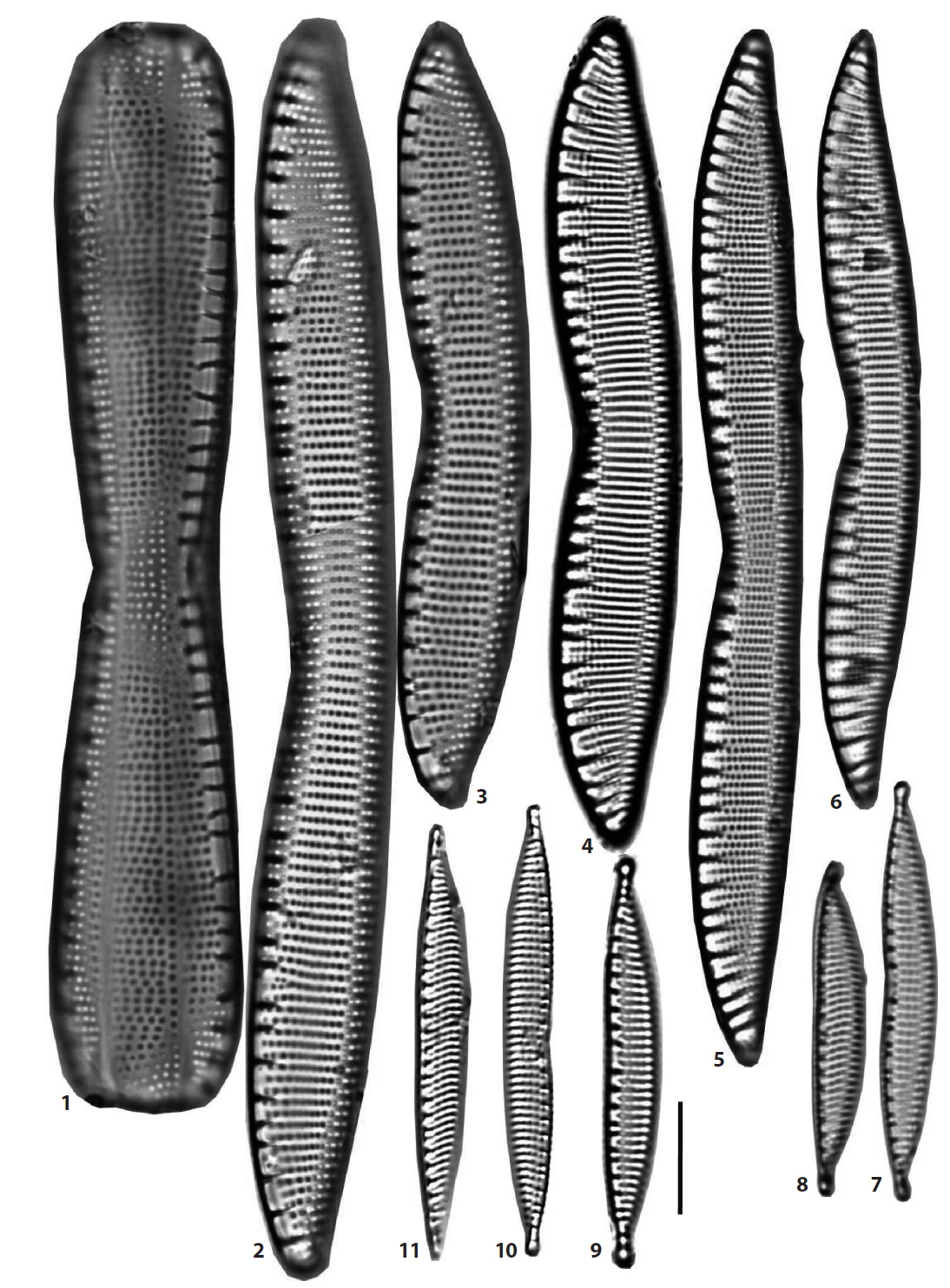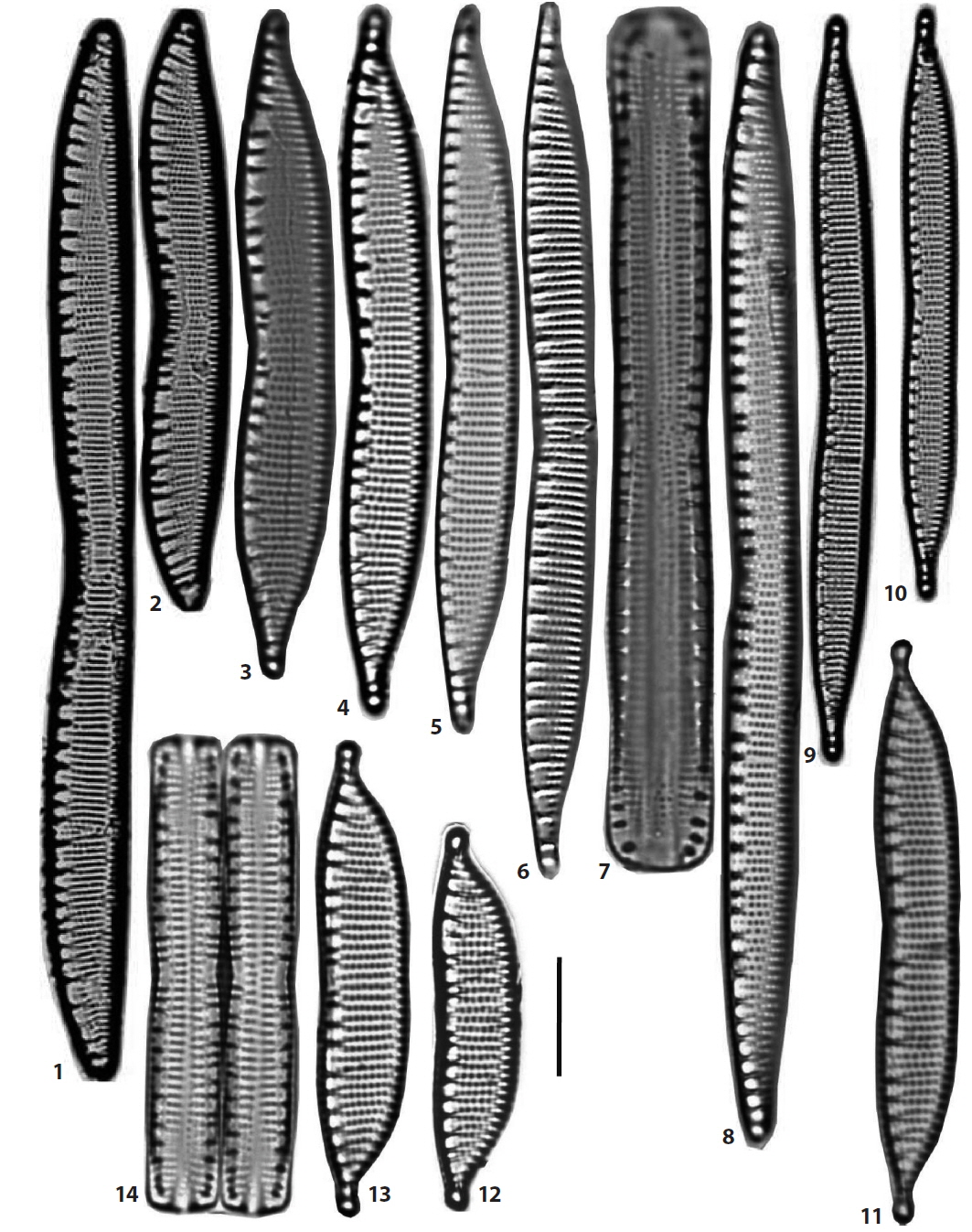Hantzschia diatoms were collected from a variety of sediments in the estuarine area of the Nakdong River. The identification of Hantzschia diatoms are based on valve outlines, the shapes of valve ends, a number of striae and areola density, shape and density of the fibulae, and the shape of proximal raphe endings. These are suggested as important characters in the classification of Hantzschia diatoms (Zidarova et al. 2010). The morphology of the girdle is also considered as an important character. The morphological characteristics that can be obtained from light microscopy are used to confirm the Hantzschia diatoms to species level. The 19 species were found in this diatom survey, but it was not possible to identify or confirm four species of Hantzschia. The outlines or dimensions of valves, and the density of striae and fibulae are summarized as follows, and important characters are added. Eleven Hantzschia species are newly reported to Korea, and these are marked with asterisks before the scientific name.
(1) Hantzschia amphioxys (Ehrenberg) Grunow in Cleve and Grunow 1880 (Pl. 3, Figs. 11 and 12) (Krammer and Lange-Bertalot 1988, p. 128, pl. 88: 1−7). Valves 19.5−29.3 μm in length, 4−6 μm in breadth of the central parts. Striae 22−26 rows in 10 μm and fibulae more or less regularly distant, 12−13 in 10 μm. Small sized diatoms in these areas, and occurring rarely in upper freshwater reaches, MUL, PYN and GUP area, in June and October.
(2) Hantzschia amphioxys f. capitata O. Müller 1909 (Pl. 3, Fig. 10) (Cleve-Euler 1952, p. 49, f. 1419t). Synonym: Hantzschia amphioxys var. capitata (O. Müller) Cleve-Euler 1948. Valves 47.5 μm in length, 7.5 μm in breadth of the central parts. Striae 26 rows in 10 μm and fibulae more or less regularly distant, 8 in 10 μm. The ends of valve distinctly capitate, and occurring very rarely in the most upper freshwater reach, WON area.
(3) Hantzschia amphioxys var. 1. (Pl. 4, Fig. 1). Valves 72−75 μm in length, 7−8 μm in breadth of the central parts. Striae 22−23 rows in 10 μm and fibulae more or less regularly distant, 8−9 in 10 μm. The ends of valve long protracted and capitate. Occurring very rarely in the most upper freshwater reach, WON area.
(4) *Hantzschia baltica Simonsen 1960 (Pl. 4, Fig. 2) (Krammer and Lange-Bertalot 1988, p. 130, pl. 92: 8, 9). Valves 52 μm in length, 8 μm in breadth of the central parts. Striae very fine and unresolved in light microscopy, and fibulae irregularly distant, 13 rows in 10 μm. Occurring only in SIN sampling site and very rare.
(5) *Hantzschia distinctepunctata (Hustedt) Hustedt in Schmidt et al. 1921 (Pl. 3, Figs. 1−3) (Krammer and Lange-Bertalot 1988, p. 131, pl. 88: 8−10). Valves 40.5−69 μm in length, 5.4−7 μm in breadth of the central parts. Striae 11−13 rows in 10 μm, puncta on a stria 14 in 10 μm, and fibulae irregularly distant, 5−7 in 10 μm. The morphology of the species is somewhat similar with H. virgata var. leptocephala, but the breadth of the valve gradually narrows towards the ends of valve. Occurring rarely in many sites of the estuarine area, but more frequently in the upper freshwater area along the river, in June and October.
(6) *Hantzschia elegantula (Østrup) Witkowski, Lange- Bertalot & Metzeltin 2000 (Pl. 4, Figs. 3 and 4) (Witkowski et al. 2000, p. 362, pl. 178: 14, 15). Basionym: Hantzschia amphioxys var. elegantula Østrup 1910. Valves 55−62 μm in length, 6−6.5 μm in breadth of the central parts. Striae 20−21 rows in 10 μm and fibulae irregularly distant, 9−10 in 10 μm. Occurring rarely in JAK and SIN site and common in this site.
(7) *Hantzschia longiareolata Garcia-Baptista 1993 (Pl. 3, Figs. 13−15) (Garcia-Baptista 1993, p. 32, f. 33−25, 39, 41, 42). Valves 36−54.5 μm in length, 4−4.5 μm in breadth of the central parts. Striae 13−15 rows in 10 μm, puncta on striae 16−20 in 10 μm, and fibulae more equidistant than other taxa, 6−8 rows in 10 μm. The local specimens are consistent with the original description, but the fibulae are more sparse. Occurring mainly in DOYN, and rare at this site, mainly in November.
(8) *Hantzschia marina (Donkin) Grunow in Cleve and Gunow 1880 (Pl. 3, Figs. 7−9) (Krammer and Lange-Bertalot 1988, p. 132, pl. 93: 1−6). Valves 50−87 μm in length, 6−9.5 μm in breadth of the central parts. Striae 5−8 rows in 10 μm, and fibulae regularly distant from each other, 7−8 in 10 μm. Fibula lying in the ventral end of the transapical costa in the valve and the same numbers of fibulae and costae in 10 μm. Occurring rarely in some sand flats, JIN, DOYN, and DOYS in intertidal areas and mainly in winter.
(9) *Hantzschia pseudomarina Hustedt in Schmidt 1922 (Pl. 4, Fig. 9) (Schmidt 1922, pl. 345: 19−21; Witkowski et al. 2000, p. 364, pl. 175: 8, 9, pl. 178: 12, 13). Valves 48.5 μm in length, 5 μm in breadth of the central parts. Striae 13 rows in 10 μm, and fibulae regularly distant, 9 in 10 μm. Occurring rarely in DOYS sand flat.
(10) *Hantzschia virgata (Roper) Grunow 1880 (Pl. 2, Figs. 4−6) (Cleve-Euler 1952, p. 52, fig. 1422a−c; Krammer and Lange-Bertalot 1988, p. 130, pl. 90: 1−3). Valves 55−92 μm in length, 6−8.5 μm in breadth of the central parts. Striae 12−13 rows in 10 μm, puncta on striae 15−20 in 10 μm, and fibulae irregularly distant, 5−6 rows in 10 μm. The valve is closely related to H. virgata var. kariana in valve outline but differs in the denser transapical striae and finer puncta on striae. In winter, occurring rarely in two sites, DOYS and JIN, sand bars composed of typical sand or coarse sand, and open sites along the sand bars.
(11) *Hantzschia virgata var. gracilis Hustedt 1922 (Pl. 1, Figs. 3−7) (Krammer and Lange-Bertalot 1988, p. 131, pl. 90: 4−6). Valves 56.5−74 μm in length, 5−7 μm in breadth of the central parts. Striae 12−13 rows in 10 μm, puncta on striae 17−20 in 10 μm. Fibulae very long, longer towards the ends, irregularly distant, and 5−7 in 10 μm. The valves are wide in breadth as the valve decreases in length, and the ratios of the length to the breadth gradually increase from 14.8 in large forms to 8.1 in small forms. The most abundant species of genus Hantzschia in this area, particularly abundant in JIN, DOYN, and DOYS, typical sand bars of open shore, in November.
(12) *Hantzschia virgata var. kariana Grunow 1880 (Pl. 2, Figs. 1−3) (Cleve-Euler 1952, p. 52, fig. 1422d). Valves 54.6−112 μm in length, 7.5−10 μm in breadth of the central parts. Striae 9−10 rows in 10 μm, puncta on striae 12−15 in 10 μm, fibulae very long and irregularly distant, and 4−6 in 10 μm. The valve deeply constricted in the middle parts in view of girdle and rounded at the ends of the valve. Occurring in the intertidal area below JAK sampling site, particularly abundant in SIN and DOYS site.
(13) *Hantzschia virgata var. leptocephala Østrup 1910 (Pl. 1, Figs. 11−14) (Witkowski et al. 2000, p. 365, pl. 176: 8−10). Valves 32−54.5 μm in length, 7−7.5 μm in breadth of the central parts. Striae 11−13 rows in 10 μm, puncta on striae 17 in 10 μm, and fibulae irregularly distant, 5 rows in 10 μm. The valve sharply decreased in breadth towards the ends and the ends of the valve narrowly capitate. Occurring in five sites, MUL, PYN, GUP, SAJN, and NAMS, and the most abundant in MUL site.
(14) *Hantzschia weyprechtii Grunow 1884 sensu Hustedt in Schmidt 1922 (Pl. 4, Figs. 5−8) (Schmidt 1922, pl. 345: 1 and 2. non sensu Krammer and Lange-Bertalot 1988, p. 129, pl. 92: 1−4). Valves 60−84.7 μm in length, 6.3−8.5 μm in breadth of the central parts. Striae 29 rows in 10 μm and fibulae irregularly distant, 7−8.5 rows in 10 μm. Many intercalary bands in the girdle view. Occurring only in three sites, DOYN, DOYS, and JAN, common in DOYN and very rare in JAN site.
(15) Hantzschia sp. 1 (Pl. 1, Figs. 9 and 10). Valves 50−62.5 μm in length, 3.7−4.2 μm in breadth of the central parts. Striae 16−17 rows in 10 μm, puncta on striae 16−17 in 10 μm, and fibulae more or less regularly distant, 7−8 in 10 μm. This species is similar with H. virgata var. gracilis in valve outline, but more slender and largely differs in the density of striae and fibulae on the valve. Occurring very rarely in JAN area.
(16) Hantzschia sp. 2 (Pl. 1, Figs. 1 and 2). Valves 45−89.5 μm in length, 5.5−6.5 μm in breadth of the central parts. Striae 16−17 rows in 10 μm, puncta on striae 20−26 in 10 μm, and fibulae more or less regularly distant, 6−8 in 10 μm. This species is closely related with H. virgata but differs with in the finer striae and fibulae on the valve.
(17) Hantzschia sp. 5 (Pl. 2, Figs. 7−11). Valves 29.5−42 μm in length, 4−4.5 μm in breadth of the central parts. Striae 13−14 rows in 10 μm, and fibulae more or less regularly distant, 7−8 rows in 10 μm. Valve lanceolate in outline, the dorsal margin of the valve convex, the ventral margin of the valve weakly convex, but constricted in the middle. Striae parallel throughout the valve face, but sometimes obliquely arranged. Occurring in the lowest sites of these areas (i.e., NAMS, DOYN, and DOYS), but very rare.
(18) Hantzschia sp. 6 (Pl. 3, Figs. 4−6). Valves 64−110 μm in length, 6−8.5 μm in breadth of the central parts. Striae 14−15 rows in 10 μm, puncta on striae 11−13 in 10 μm, and more or less regularly distant, 6−7 in 10 μm. Puncta on a stria are located distantly, and many puncta are arranged apically on the girdle bands. Occurring in five sites, ANM, JIN, DOYN, DOYS, and DAD site, and very rare.
(19) Hantzschia sp. 7 (Pl. 1, Fig. 8). Valves 95−107 μm in length, 5.5−6 μm in breadth of the central parts. Striae 12−14 rows in 10 μm, puncta on striae 12−13 in 10 μm, and more or less regularly distant, 6−7 in 10 μm. The valve is long and slightly hantzschioid in outline, but more or less symmetrical apically. This species is closely related with H. virgata var. gracilis in morphology, but differs in the morphology of the valve ends. Occurring very rare in one site, DOYN area.
Diverse Hantzschia species were found in the sediments of this estuary, particularly around the H. virgata and the neighboring taxa. They show large morphological variations within a single species or between closely related taxa in the forms of valves and girdles of frustules. They are overlapped in the form of outlines and ends of valves, and the dimensions. Some Hantzschia taxa occurring in this local area also represent a cryptic species complex that are typically very closely related in morphological and ecological characteristics between neighboring species. Hantzschia virgata and some species are closely related each other, and their precise taxonomic accounts can not be easily determined. In spite of the overlapping morphology between some species, diatom assemblages of H. virgata occurring in the local area are classified into eight taxa, H. virgata, three infraspecific and four unconfirmed taxa, and two taxa, H. distinctepunctata and H. longiareolata with the view of traditional classification systems. Yet their refined classification and relationships are further to be done on the basis of detailed ultrastructure and morphological evidences.
Diatom assemblages of H. virgata have many infraspecific varieties to reflect their heterogeneity. Large intraspecific variations of H. virgata and the related species were already reported by Round (1970) and Mann (1999), and they are constituted with a mixture of morphological characters. Mann (1981) described variations of H. virgata from marine habitats, especially in the forms of valves, the density of fibulae and striae. Especially, morphological variations of sympatric Hantzschia populations are emphasized (Mann 1989).
Valves of this genus diatoms occurring in the estuarine sediments are all hantzschioid or slightly dorsiventral in outline, and these features are characterized by raphe presence on the ventral margins of same sides of the valve. And they show commonly a variety of protracted ends of the valve, and the more distant fibulae in the central parts. However, the species within the genus have some heterogeneous characters such as the valve outlines, the stria structure and areolar morphology. For examples, two types of ventral margins of the valve are observed, the concave and straight ones in the middle parts. Hantzschia baltica, H. elegantula and H. weyprechtii belong to the form of the straight ventral margins and have the similar structure of valves, and the other species to the concave forms. In the structure of the diatom frustule, the lack of homogeneity or commonness in the genus Hantzschia is already suggested by Round et al. (1990). The taxonomic identities of Hantzschia diatoms collecting in local areas are to be solved and further studies of detailed morphology, clonal cultures, or genetic information are needed.
With a few researches on the morphology of Hantzschia diatoms, in the diatom taxonomy, marine Hantzschia species have not drawn attention rather than the freshwater or non-marine groups. Many Hantzschia species from the freshwaters have been separated from the existing taxa or some are persistently being revised with the narrow species concepts (Lange-Bertalot 1993, Zidarova et al. 2010). The well-known species as H. amphioxys has very variable in morphology and sizes, and a number of taxa are separated or revised as independent species from H. amphioxys and its variety (Lange-Bertalot 1993). Many new species are designated from Antarctic regions (Zidarova et al. 2010).
Diatoms were exclusively predominant over the microphytobenthos of this local sediment, while Hantzschia diatoms were relatively scarce in this benthic diatom assemblage. The relative abundances of Hantzschia diatoms account for less than 3% over all sampling areas with an exception of a few samples, and the relative abundance of each species are classified under five categories in Table 1. However, in the low abundance of the Hantzschia diatoms, they are frequently encountered with large cell size in the procedures of cell counting under light microscopy. Some samples collected from JIN, SINW, and DOYN area were colonized by H. virgata var. gracilis or H. weyprechtii to show higher dominance of up to 20%.
Hantzschia species are differentially distributed along the sediment environments to show a clear zonation or patterns. The spatial distributions of Hantzschia species are summarized in Table 1. Three Hantzschia taxa, H. amphioxys, H. distinctepunctata, and H. virgata var. leptocephala, inhabit the freshwater areas, and H. virgata var. kariana and H. elegantula in more saline waters. The other five unidentified species are more abundant in coastal areas. Particularly, H. marina, H. virgata, and H. virgata var. kariana prefer the coastal lines of the shore, as typical marine diatoms. Hantzschia distincepunctata, H. virgata var. kariana, and Hantzschia sp. 6 show wider distribution. On the other hand, H. baltica, H. elegantula, and H. pseudomarina, occur in only one site.
Hantzschia diatoms were concentrated mainly in three locations, in the abundance and frequency, JIN (Site 12), DOYN (Site 20), and DOYS (Site 21), and the next rich locations were JAK (Site 7), PYN (Site 3), MUL (Site 2), and NAMS (Site 19). These sand flats are composed of typically coarse sand grains with above 90% sand in grain composition, while Hantzschia diatoms were poorly or scarcely discovered in non-sand or mud-containing sediments, silty sand (PYNB, JANC, JAND), muddy sand (DOK, SON), sandy silt (JANE), and sandy mud (ANM, SINB). Through the distributional patterns, it is clear that Hantzschia diatoms are related to sand grains as typically attached forms.
In Korea, H. amphioxys (Ehrenberg) Grunow is the most popular and common in the genus, and has been reported frequently from a variety of freshwaters by many authors, but three infraspecific taxa, H. amphioxys f. capitata O. Müller, H. amphioxys var. vivax Grunow, and H. amphioxys var. xerophila Grunow, occurred in only one area (Chung 1979, Chung and Noh 1987, Lee 1987). The other three Hantzschia species, H. hermanni Hustedt, H. linearis (O. Müller) Cleve, and H. virgata var. capitellata Hustedt, were reported from freshwater or brackish habitats (Chung and Watanabe 1984, Chung et al. 1985, Lee et al. 1992), and Hantzschia spectabilis (Ehrenberg) Hustedt in southern coast (Chung and Lee 2008). As diatoms of the genus Hantzschia are widely distributed and the variations of valve morphology are great, a number of further new Hantzschia taxa to Korea will be found.




